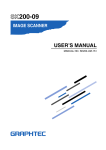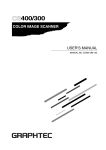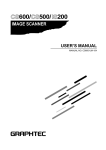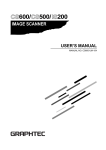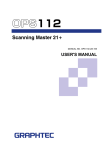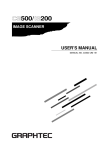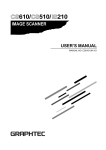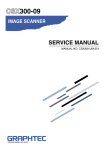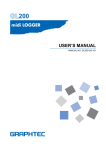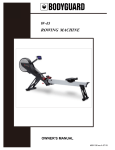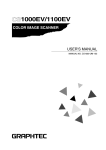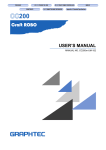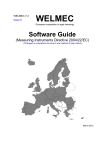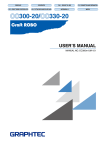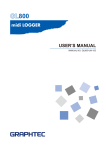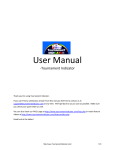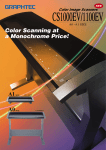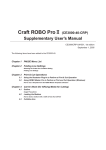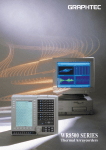Download CSX300-09 USER`S MANUAL
Transcript
CSX300-09 IMAGE SCANNER USER’S MANUAL MANUAL NO. CSX300-UM-151 TO ENSURE SAFE AND CORRECT USE • To ensure the safe and correct use of your Image Scanner, read this manual thoroughly prior to use. • After reading this manual, store it in a safe place for reference as necessary. • Do not allow small children to touch the Image Scanner. • The following describes important points for safe operation. Be sure to observe them strictly. Conventions Used in This Manual To ensure the safe and correct use of the Image Scanner as well as to prevent human injury and property damage, the safety precautions provided in this manual are ranked into the three categories described below. Be sure to gain a full understanding of the difference between each of the categories before reading the manual. Danger This category provides information that, if ignored, is highly likely to cause fatal or serious injury to the operator. Warning This category provides information that, if ignored, is likely to cause fatal or serious injury to the operator. Caution This category provides information that, if ignored, could cause injury to the operator or physical damage to the Image Scanner. Description of Safety Symbols The symbol indicates information that requires careful attention (including warnings). The specific point requiring attention is symbol. described by an illustration or text within or next to the The symbol indicates an action that is prohibited. Such prohibited action is described by an illustration or text within or next to the symbol. The symbol indicates an action that must be performed. Such imperative action is described by an illustration or text within or next to the symbol. i SAFETY PRECAUTIONS To ensure the safe and correct use of your Image Scanner, be sure to observe the following points. Installation Precautions Warning Do not install the scanner in the vicinity of volatile solvents such as alcohol or thinner. • A volatile solvent coming into contact with any of the internal electrical components may result in a fire hazard or electric shock. Benzine Thinner Do not place objects such as those listed below on top of the scanner. • Objects such as these coming into contact with any of the internal electrical components may result in a fire hazard or electric shock. ♦ Metallic objects such as necklaces ♦ Objects such as glasses, vases, houseplants, etc. that contain water or other fluids If any of these objects does come into contact with the internal electrical components immediately turn off the power, remove the plug from the power outlet, and either contact the store where you purchased your scanner or your nearest Graphtec representative. Caution Do not use the scanner in an unstable location such as on a slope or a location that is subject to a lot of vibration. • Such locations may cause the scanner to tip over and cause injuries. Do not place heavy objects on the scanner. • Such objects may tip over or fall off, causing injuries. Do not use sharp, pointed articles on the scanner. • Such action may impair the scanner’s performance and cause the scanner to malfunction or break down. ii Do not exert pressure on the scanner. • Such action may impair the scanner’s performance and cause the scanner to malfunction or break down. • Such action could cause injury to the operator. Avoid installing the scanner in any of the following locations. • Use in such locations may result in a fire hazard or electric shock. ♦ Excessively humid or dusty locations ♦ Locations exposed to direct sunlight ♦ Locations exposed to high temperatures ♦ Locations near flames or moisture Do not install, use, or store the scanner in a location that does not meet the specified temperature and humidity ranges. • Such location may impair the scanner’s performance due to deformation or damage, and cause the scanner to malfunction or break down. Do not install, use, or store the scanner in a location subject to excessive mechanical vibration or electrical noise. • Such location may impair the scanner’s performance and cause the scanner to malfunction or break down. Leave plenty of space around the scanner. • Leave sufficient space for operations in front of and behind the scanner. When using the scanner on a desktop At least 300 mm At least 300 mm At least 300 mm At least 200 mm iii Power Supply Precautions Warning Do not damage the power cable, or modify it in any way. Moreover, do not place heavy objects on the power cable, pull on the cable, or bend it excessively. • There may be current leakage from the damaged parts, resulting in a fire hazard or electric shock. • Do not unplug or plug in the power cable when your hands are wet. Such action may result in electric shock. Do not connect multiple devices to the same power outlet. • Use of the scanner in such a condition may result in a fire hazard or electric shock. Do not bundle or tie-wrap the power cable. • Use of a bundled power cable may result in a fire hazard or electric shock. Make sure that the power cable is firmly inserted into the power outlet. • Use of a power cable when the plug is not completely inserted into the power outlet may result in a fire hazard or electric shock. Do not use a power cable other than the one supplied with your scanner. • Use of a different power cable may result in a fire hazard or electric shock. Do not connect the inkjet printer to a non-rated power supply. Spec ifie ratin d g • Use of a different supply voltage may result in electrical shock or a fire hazard due to current leakage. Prohibited Before disconnecting or reconnecting the power cable, be sure to turn off the scanner. • Failure to do so may impair the scanner’s performance and cause the scanner to malfunction or break down. • Failure to do so may result in electric shock. iv Caution When disconnecting the power cable, be sure to hold on to the plug, and not pull on the cable itself. • Pulling on the cable will expose the core wires, or cause damage such as broken wires. Current leakage from the exposed or damaged areas may result in a fire hazard or electric shock. Before cleaning the scanner, be sure to unplug the power cable from the power outlet. • Failure to do so may result in electric shock. Do not allow dust or metallic matter to adhere to the power plug. • If the power plug becomes dirty, thoroughly wipe it clean. • The use of a dirty power plug may result in a fire hazard or electric shock. As a general rule, do not use an extension cord. • Use of an extension cord may result in a fire hazard or electric shock. If you must use an extension cord, unbundle it, and make sure that the power plug is firmly inserted into the extension cord socket. Make sure that the power plug can be readily unplugged at any time, and that there are no objects placed in its vicinity. • Objects placed in the vicinity of the power plug will prevent its removal in an emergency. v Handling Precautions Warning Do not disassemble or modify the scanner. • Such actions may result in a fire hazard or electric shock. If the scanner makes an unusual noise, generates smoke, overheats, emits a strange odor, or otherwise functions abnormally, immediately turn off the power, remove the plug from the power outlet, and either contact the store where you purchased your scanner or your nearest Graphtec representative. • Use of the scanner in such a condition may result in a fire hazard or electric shock. Do not use flammable aerosols or similar products in the vicinity of the scanner. • The gas contained in the spray may cause a fire hazard or electric shock if it comes into contact with the scanner’s internal electrical components. Before moving the scanner, make sure that the power button is in the “off” position and that the power plug has been removed from the power outlet. • If the scanner is moved while it is still plugged into the power outlet, the power cable may be damaged and cause a fire hazard or electric shock. If the scanner is damaged from being dropped or other impact, turn off its power and remove the power plug from the power outlet. •Use of the scanner in such status may result in a fire hazard or electric shock. •Request repair by contacting the store where you purchased your scanner or your nearest Graphtec representative. •Never try to perform repair yourself. Repair work by inexperienced personnel is extremely dangerous. vi Caution Take care not to drop metallic items such as paper clips or staples, or spill water, other fluids or flammable solvents (alcohol, benzene, thinner, etc.) inside the scanner. • Metallic items or fluids coming into contact with the internal electrical components may result in a fire hazard or electric shock. If such items or fluids fall or are spilled inside the scanner, immediately turn off the power, remove the power plug from the power outlet and either contact the store where you purchased your scanner or your nearest Graphtec representative. Do not insert your hands inside the scanner during a scanning operation or when a document is being fed. • Moving parts inside the scanner may cause injuries. If the scanner will not be used for an extended length of time, such as at night, turn off the power button as a safety precaution. • In addition, if the scanner will not be used for longer periods of time, such as a long weekend, remove the power plug from the power outlet as an additional safety precaution. vii Maintenance and Inspection Precautions Warning Be sure to turn off the power and remove the power plug from the power outlet before performing any cleaning operations. •Failure to do so may result in a fire hazard or electric shock. Moreover, there is a risk of injury if the scanner starts to move during a cleaning operation. • A volatile solvent coming into contact with any of the internal electrical components may result in a fire hazard or electric shock. Neutral Detergent To clean the scanner, use a cloth that has been dampened with neutral detergent and then well wrung out. Do not use volatile solvents such as alcohol, benzene or thinner to clean the scanner. Do not attempt to lubricate the scanner’s mechanisms. • Such action may impair the scanner’s performance and cause the scanner to malfunction or break down. • Such action may cause a fire hazard or electric shock due to a short circuit or overheating. Caution At least once a year, remove the power plug from the power outlet and clean the prongs and surrounding areas. • A build-up of dust may result in a fire hazard. When cleaning or checking the inside of the scanner, make sure that metallic objects such as a necklace or bracelet do not come into contact with any of the internal components. • Such actions may result in injuries or an electric shock. When removing a document that has become jammed inside the scanner, take care not to cut your fingers on the edges of the document. • Such actions may result in injuries. viii WARNING Only computers or peripherals (computer input/output devices, terminals, printers, etc.) certified as complying with the limits for a Class B digital device, pursuant to Part 15 of the FCC Rules, may be attached to this product when this product is operated in a residential environment. Operation with non-certified peripherals is likely to result in interference to radio and TV. FEDERAL COMMUNICATIONS COMMISSION RADIO FREQUENCY INTERFERENCE STATEMENT "This equipment has been tested and found to comply with the limits for a Class B digital device pursuant to Part 15 of the FCC Rules. These limits are designed to provide reasonable protection against harmful interference in a residential installation. This equipment generates, uses, and can radiate radio frequency energy and, if not installed and used in accordance with the instructions, may cause harmful interference to radio communications. However, there is no guarantee that interference will not occur in a particular installation. If this equipment does cause harmful interference to radio or television reception, which can be determined by turning the equipment off and on, the user is encouraged to try to correct interference by one or more of the following measures: • Reorient or relocate the receiving antenna. • Increase the separation between the equipment and receiver. • Connect the equipment into an outlet on a circuit different from that to which the receiver is connected. • Consult the dealer or an experienced radio/TV technician for help." ix INTRODUCTION Thank you for choosing the Graphtec CSX300-09 Image Scanner. Please read this manual thoroughly before attempting to use your new product to ensure that you use it safely and correctly. Notes on this Manual (1) No part of this publication may be reproduced, stored in a retrieval system, or transmitted, in any form or by any means, without the prior written permission of Graphtec Corporation. (2) The product specifications and other information in this manual are subject to change without notice. (3) While every effort has been made to provide complete and accurate information, please contact your nearest Graphtec representative if you find any unclear or erroneous information or wish to make other comments or suggestions. (4) Notwithstanding the stipulation in the preceding paragraph, Graphtec Corporation assumes no liability for damages resulting from either the use of the information contained herein or the use of the product. Registered Trademarks All names of companies, brands, logotypes, and products appearing in this manual are the trademarks or registered trademarks of their respective companies. Copyright This User’s Manual is copyrighted by Graphtec Corporation. International ENERGY STAR® Program As an ENERGY STAR®* Partner, Graphtec. has determined that this product meets the ENERGY STAR® guidelines for energy efficiency. * The International ENERGY STAR® Office Equipment Program is a global program that promotes energy saving through the use of computer and other office equipment. The program backs the development and dissemination of products with functions that effectively reduce energy consumption. It is an open system in which businesses can participate voluntarily. The targeted products are office equipment such as computers, monitors, printers, faxes, copiers. Their standards and logos are uniform among participating nations. I Usage precautions Do not lift or move the scanner by holding the top cover section, as doing so may damage the scanner. Always lift the scanner by holding the underside. OK NG Top cover section Take care not to get your fingers caught in the gap between the top cover and the scanner unit when opening and closing the top cover. Top cover <Opening the top cover> Do not hold the rear section of the top cover when opening it. Top cover <Closing the top cover> Keep your hands away from the front of the scanner when closing the top cover. Always ensure that you open the top cover and remove the cushion material before using the scanner. (See Section 4.1, “Opening and Closing the Top Cover”.) Scanner warm-up A warm-up period is not usually required for the CSX300-09. However, if you plan to scan a color document (in particular a document with many light colors), we recommend that you allow the scanner to warm up for 10 minutes before scanning the document. II CONTENTS TO ENSURE SAFE AND CORRECT USE ................................................................................... i SAFETY PRECAUTIONS Installation Precautions .................................................................................................. ii Power Supply Precautions ............................................................................................ iv Handling Precautions .................................................................................................... vi Maintenance and Inspection Precautions .................................................................... viii INTRODUCTION Notes on this Manual ...................................................................................................... I Registered Trademarks ................................................................................................... I Copyright ........................................................................................................................ I International ENERGY STAR® Program ........................................................................ I Usage precautions ......................................................................................................... II Scanner warm-up .......................................................................................................... II CHAPTER 1 BEFORE USING THE SCANNER 1.1 1.2 1.3 Checking the Contents of the Package .......................................................................... 1-1 Part Names and Functions ............................................................................................. 1-2 Front View/Control Panel ............................................................................................ 1-2 Rear View ................................................................................................................... 1-3 Assembling the Scanner ................................................................................................ 1-4 Attaching the document support plates ...................................................................... 1-4 Attaching and using the cable clamp .......................................................................... 1-4 CHAPTER 2 CONNECTION AND PREPARATIONS 2.1 2.2 2.3 2.4 2.5 2.6 2.7 Connecting to the Power Supply .................................................................................... 2-1 Turning the Power On and Off ........................................................................................ 2-2 Turning the Power On ................................................................................................. 2-2 Turning the Power Off ................................................................................................. 2-2 Notes on the power-saving mode ............................................................................... 2-3 System Requirements .................................................................................................... 2-4 Recommended environment ....................................................................................... 2-4 Connecting the Scanner to a Computer ......................................................................... 2-5 USB Connection ......................................................................................................... 2-5 Installing the Driver Software ......................................................................................... 2-6 For Windows Vista ...................................................................................................... 2-6 For Windows XP ......................................................................................................... 2-8 For Windows 2000 .................................................................................................... 2-10 Checking the Interface Connection .............................................................................. 2-12 For Windows Vista .................................................................................................... 2-12 For Windows XP ....................................................................................................... 2-13 For Windows 2000 .................................................................................................... 2-14 Installing the Scanning Master 21+ Application ........................................................... 2-15 Operating environment ............................................................................................. 2-15 Installation procedure ............................................................................................... 2-15 CHAPTER 3 LOADING A DOCUMENT 3.1 3.2 Compatible Document Types ......................................................................................... 3-1 Loading a Document ...................................................................................................... 3-2 III 3.3 3.4 3.5 Handling Documents According to their Material and Thickness ................................... 3-4 Distance Correction ........................................................................................................ 3-5 Using the Carrier Sheet .................................................................................................. 3-6 CHAPTER 4 DAILY MAINTENANCE 4.1 4.2 4.3 4.4 4.5 4.6 4.7 4.8 4.9 Opening and Closing the Top Cover ............................................................................... 4-1 Cleaning the Feed Rollers .............................................................................................. 4-2 Cleaning the Document support Rollers ........................................................................ 4-3 Cleaning the Gap Rollers ............................................................................................... 4-4 Cleaning the Push Rollers .............................................................................................. 4-5 Cleaning the Image Sensors (Transparent Contact Plates) ........................................... 4-6 Cleaning the Sensors ..................................................................................................... 4-7 Removing a Jammed Document .................................................................................... 4-8 Scanner Calibration ........................................................................................................ 4-9 Preparation and checks .............................................................................................. 4-9 Launching the Scanner Adjustment Program ............................................................. 4-9 Calibration ................................................................................................................. 4-10 CHAPTER 5 TROUBLESHOOTING PROCEDURES 5.1 5.2 5.3 5.4 5.5 5.6 5.7 5.8 5.9 5.10 5.11 5.12 5.13 5.14 5.15 The scanner Is turned on but doesn’t operate at all ....................................................... 5-1 The scanner operates improperly after connection to the computer .............................. 5-1 The control panel’s red ERROR LED is lit ...................................................................... 5-1 The control panel’s red ERROR LED is flashing ............................................................ 5-2 The document isn’t properly fed to the initial scanning position ..................................... 5-2 The scanned image data is completely white or completely black ................................. 5-2 The image quality has dropped ...................................................................................... 5-2 The scanned data is incorrectly aligned ......................................................................... 5-3 Smudges not appearing in the original document appear in the scanned data ............. 5-3 The color intensity of the image data differs .................................................................. 5-3 The document length differs from the scanned data length ........................................... 5-4 Stripes or moire patterns which are not in the original document appear in the scanned data ................................................. 5-4 The scanned image data is distorted ............................................................................. 5-4 The scanned image data is patchy ................................................................................ 5-4 The document cannot be fed correctly ........................................................................... 5-4 APPENDIX Appendix A Options and Consumables ................................................................................... A-1 Appendix B Specifications ....................................................................................................... A-2 Appendix C External Dimensions ............................................................................................ A-3 INDX ................................................................................................................................................ I-1 IV CHAPTER 1 BEFORE USING THE SCANNER 1.1 Checking the Contents of the Package Check to confirm that all of the items shown below are present. If any item is missing, promptly contact the store where you purchased your scanner or your nearest Graphtec representative. Power cable ...1 Scanner unit ...1 Cable clamp ...1 USB cable ...1 Document support plates ...1 Calibration sheet ...1 Carrier sheet ...1 Cleaning paper ...1 pack Driver software ...1 USER’S MANUAL ...1 CSX300-09 IMAGE SCANNER USER’S MANUAL MANUAL NO.CSX300-UM-151 Scanner unit Calibration sheet Power cable Carrier sheet USB cable Cleaning paper Cable clamp Driver software 1-1 Document support plates User’s Manual 1.2 Part Names and Functions Front View/Control Panel (2) Paper sensors Control Panel (5) POWER button/LED (4) Document guides (6) PAPER LED (7) ERROR LED (1) Top cover (8) EJECT key (9) STOP key (3) Top cover open levers Front View (1) Top cover ....................... Open the top cover to clean the document hold-down unit and transparent contact plates. (2) Paper sensors ............... These sense whether a document is present in the scanner. (3) Top cover open levers ... Press these levers to open the top cover. If the top cover is opened during a scanning operation, the operation will be stopped compulsorily. (4) Document guides .......... Use these guides to determine the position of a document when you load the document. Control Panel (5) POWER button/LED (blue) ................................ Controls the on/off status of the power supply to the scanner. Lit: The scanner is turned on. Flashing: Flashes when the scanner is in power-saving mode. Unlit: The scanner is turned off. (6) PAPER LED (green) ...... Lit: Lights when a document has been loaded. Flashing: Flashes while image data is being scanned. Unlit: Normal status (Local status). (7) ERROR LED (red) ......... Lit: Lights to indicate a hardware error. Flashing: Flashes when any of the following occurs: • A document is detected during the self-test when the scanner is turned on • When a paper jam is detected • When the top cover is open • When the document length is shorter than the specified scan length*1 *1 When "Confirm" has been selected for the End-of-paper Processing setting in the driver software Unlit: Normal status (8) EJECT key .................... Press this key to feed the document. If this key is pressed when the scanner is in document-loaded status, the document-loaded status is canceled and the document is ejected to the front of the scanner. If this key is pressed after the scanning operation has been canceled or after scanning of the document was halted partway through the scanning operation, the document-loaded status is canceled and the document is ejected to the rear of the scanner. 1-2 (9) STOP key ...................... Compulsorily stops scanning/feeding of the document. If the ERROR LED flashes when the top cover is in the closed status, press this key to suspend the scanning operation and check whether a paper jam has occurred. Rear View (13) Document support plates (10) USB connector (14) Cable clamp (11) Power inlet (12) Main power switch (10) USB connector ............ Used to connect the USB interface cable. (11) Power inlet ................... Used to connect the power cable. (12) Main power switch ....... Used to turn the main power supply on or off. (13) Document support plates ................................ Used to support the document that is being ejected. (14) Cable clamp ................ Used to bundle the power cable and USB cable together and fasten them in place. 1-3 1.3 Assembling the Scanner Please see the separate Stand Assembly Instruction Manual for instructions on how to assemble the stand. Attaching the document support plates Always be sure to install the document support plates, irrespective of the type of documents to be scanned. (1) Take one of the document support plates provided, and insert its hooks into the slots at the rear of the scanner. Insert the hooks from the top of the slots. Hooks Document support plate (2) Attach the other document support plates in the same manner. Checkpoint Detach the document support plates when moving or packing the scanner. Lift the plates up and out of the slots to detach them. Attaching and using the cable clamp Attach the cable clamp to the scanner, and then pass the power cable and USB cable through the clamp to fasten them in place. Caution Be sure to attach the cable clamp to the scanner and use it to fasten the power cable and USB cable in place. Failure to do so may affect the scanning operation. Attaching the clamp (1) Using a soft cloth that has been soaked in water or diluted neutral detergent and then firmly wrung out, wipe off any dust or dirt on the surface of the attachment location before attaching the cable clamp. Cable clamp attachment location 1-4 (2) Wipe the area once again with a soft, dry cloth to thoroughly remove any traces of moisture. (3) Peel off the adhesive sticker on the rear of the clamp and then attach the clamp to the scanner. Cable clamp Using the clamp (1) Pull up the latch at the top of the cable clamp to open the clamp. Latch (2) Pass the power cable and the USB cable through the cable clamp, and then close it. USB cable 1-5 Power cable CHAPTER 2 CONNECTION AND PREPARATIONS 2.1 Connecting to the Power Supply Connect one end of the power cable provided to the scanner’s power inlet and the other end to an AC power outlet of the rated supply voltage. AC power outlet Power inlet Power cable Caution Be sure to use the cable clamp provided with the scanner to fasten the power cable in place. Please see “Attaching and using the cable clamp” in Section 1.3, “Assembling the Scanner” for further details. 2-1 2.2 Turning the Power On and Off The LED (blue) on the [POWER] button changes as follows to indicate the scanner's power supply status. • Unlit: The scanner is turned off. • Lit: The scanner is turned on. • Flashing: Flashes when the scanner is in power-saving mode. Turning the Power On (1) Connect the power cable. (2) Turn on the main power switch (the | side). ON (3) Press the [POWER] button on the scanner's control panel. When the scanner is in the power-on status, the [POWER] button LED lights blue. ON Turning the Power Off Press the [POWER] button on the scanner's control panel. When the scanner is in the power-off status, the [POWER] button LED is extinguished. OFF Checkpoint Caution • After the scanner has been turned off, wait at least five seconds before turning it on again. • If you do not plan to use the scanner for any length of time, turn off the main power switch (the O side). Do not turn off the main power switch (the O side) on the rear of the scanner while the scanner is the power-on status. 2-2 Notes on the power-saving mode The scanner automatically switches to power-saving mode (the blue LED on the power button flashes) after approximately 12 minutes have elapsed without a document being loaded in the scanner. To return the scanner to normal status (Local status), press either the [STOP] or the [EJECT] key. To cancel the power-saving mode Checkpoint If a document has been loaded in the scanner, the scanner will not switch to power-saving mode. 2-3 2.3 System Requirements The minimum system requirements for running the scanner’s hardware and software are listed below. • Operating system: Windows 2000 Professional, XP Professional, XP Home Edition, or Vista • CPU: Pentium III, 1 GHz • Memory: 256 MB or more • Monitor: 1024 x 768 pixels, True Color or higher • Disk space: At least 10 GB*1 • Mouse • Interface: USB 2.0 interface *1 When the length of A0 or more is treated, the hard disk space is needed further. Recommended environment • CPU: Pentium 4, 2 GHz • Memory: 1 GB or more • Disk space: At least 30 GB • USB 2.0 interface (that comes standard with your computer) Checkpoint Use with a system configuration below the recommended specifications will affect the scanning speed and prevent the scanner from operating to its specified capabilities. Moreover, colors may not be displayed correctly if the number of colors that the monitor can display is 256 or less. To edit an A1-size or larger grayscale document with a resolution of 400 dpi or higher, or a 24-bit color document, you may need more than the recommended memory sizes above. 2-4 2.4 Connecting the Scanner to a Computer USB Connection A USB cable is used to connect the scanner to the computer, via the respective USB interface connectors. The connectors at the computer and scanner ends of the USB cable have different shapes. Make sure that the cable is oriented correctly before making the connection. Make sure that both the scanner and the computer are in the power-off status when connecting them. USB interface connector Computer USB cable Important Caution Checkpoint • Make sure that the USB cable is firmly inserted into the interface connectors. • The operation of the scanner cannot be guaranteed in the following cases: ♦ When the cable is connected to a USB hub or an add-on USB board. ♦ When you are using a custom-built computer or one that you have modified. ♦ When you are using a cable that is longer than 3 meters in length. (Please use the USB cable that is provided with your scanner.) • Do not perform any of the following actions: ♦ Remove or reinsert the cable while you are installing the driver. ♦ Remove or reinsert the cable while starting up the computer or the scanner. ♦ Remove or reinsert the cable while transferring data. ♦ Connect two or more scanners to a single computer. Be sure to use the cable clamp provided with the scanner to fasten the USB cable in place. Please see “Attaching and using the cable clamp” in Section 1.3, “Assembling the Scanner” for further details. Please see the separate “Quick Start Guide” for the scanner driver installation procedure. 2-5 2.5 Installing the Driver Software Checkpoint The procedure outlined below is based on the requirement that you are logged on to Windows with administrator rights. Consult your Windows manual and Windows Help for more information. For Windows Vista (1) Use the USB cable to connect the scanner to the computer, and then turn on the computer. (2) When Windows starts up, insert the CD-ROM supplied with the scanner into the CDROM drive. (3) Turn on the power to the scanner. (4) The screen shown below is displayed. Click "Locate and install driver software (recommended)". (5) The User Account Control screen is displayed. Click [Continue] to proceed with the installation. (6) The screen shown below is displayed. Click "Don't search online". (7) The screen shown below is displayed. Click "I don't have the disc. Show me other options." 2-6 (8) The screen shown below is displayed. Click "Browse my computer for driver software (advanced)". (9) The screen shown below is displayed. Click [Browse] and either select the [DRIVER] folder in the CD-ROM drive or enter a CD-ROM drive name and \DRIVER using the keyboard. Example: For drive E, enter "E:\DRIVER". (10) Click [Next]. The wizard will start searching for the driver. (11) The screen shown below is displayed. Click [Install] to proceed with the installation. 2-7 (12) The screen shown below is displayed when the wizard has finished installing the driver. Click the [Close] button to close the "Found New Hardware" wizard. (13) The Windows Vista desktop appears, and the scanner is recognized by the computer. For Windows XP (1) Use the USB cable to connect the scanner to the computer, and then turn on the computer. (2) When Windows starts up, insert the CD-ROM supplied with the scanner into the CDROM drive. The “Start” screen opens automatically. Click the [Quit] button to close the “Start” screen. (3) Turn on the power to the scanner. (4) When Windows XP starts up, the following screen appears (if Service Pack 2 has not been installed, the screen shown in (5) below appears). Select the option “No, not this time” and then click [Next]. (5) If Service Pack 2 has not been installed, the following screen appears. Select the option “Install from a list or a specific location (Advanced).” and then click [Next]. 2-8 (6) The screen shown below is displayed. Select the option “Search for the best driver in these locations” and select the check box entitled “Include this location in the search.” Click [Browse] and either select the [DRIVER] folder in the CD-ROM drive or enter a CDROM drive name and \DRIVER using the keyboard. Example: For drive E, enter "E:\English\DRIVER". (7) Click [Next]. The wizard will start searching for the driver. (8) The screen shown below is displayed. Read the explanation and make sure that you understand the contents. To continue the installation, click [Continue Anyway]. (9) The screen shown below is displayed when the wizard has finished installing the driver. Click the [Finish] button to close the “Welcome to the Found New Hardware” wizard. (10) The Windows XP desktop appears, and the scanner is recognized by the computer. 2-9 For Windows 2000 (1) Use the USB cable to connect the scanner to the computer, and then turn on the computer. (2) When Windows starts up, insert the CD-ROM supplied with the scanner into the CDROM drive. (3) Turn on the power to the scanner. (4) The screen shown below appears. Click [Next] to move to the “Install Hardware Device Drivers” screen. (5) When this screen is displayed, select the option “Search for a suitable driver for my device (recommended)” and then click [Next] to display the “Locate Driver Files” screen. (6) When this screen is displayed, select the check box entitled “Specify a location” and click [Next]. (7) The screen shown below is displayed. Click [Browse] and either select the [DRIVER] folder in the CD-ROM drive or enter a CD-ROM drive name and \DRIVER using the keyboard. Example: For drive E, enter "E:\English\DRIVER". Click [OK]. The wizard will start searching for the driver. 2-10 (8) The screen shown below is displayed when the wizard has finished searching. Click [Next]. (9) The screen shown below is displayed. Read the explanation and make sure that you understand the contents. To continue the installation, click [Yes]. (10) The screen shown below is displayed when the wizard has finished installing the driver. Click the [Finish] button. (11) The Windows 2000 desktop appears, and the scanner is recognized by the computer. 2-11 2.6 Checking the Interface Connection For Windows Vista (1) Launch the Control Panel using the [Start] menu on the Windows desktop. (2) Click "Hardware and Sound" to display the screen shown below. (3) Click "Scanners and Cameras" to display the screen shown below. Check that "Graphtec CSX300-09" is displayed here. 2-12 For Windows XP (1) Launch the Control Panel using the [Start] menu on the Windows desktop. (2) The screen shown below is displayed when you click on the “Printers and Other Hardware” icon. (3) The screen shown below is displayed when you click on the “Scanners and Cameras” icon. Check that “Graphtec CSX300-09” is displayed here. 2-13 For Windows 2000 (1) Launch the Control Panel using the [Start] menu on the Windows desktop. (2) The screen shown below is displayed when you click on the “Scanners and Cameras” icon. Check that “Graphtec CSX300-09” is displayed here. 2-14 2.7 Installing the Scanning Master 21+ Application Scanning Master 21+ "OPS112" is a software application for using a Graphtec scanner to scan image data. Operating environment Windows 2000 Professional, XP Professional, XP Home Edition or Vista Installation procedure The following steps are explained using the Windows 2000 screens. (1) Start up Windows 2000. (2) Insert the CD-ROM supplied with the scanner into the CD-ROM drive. (3) Select "Run" from the [Start] menu on the Windows desktop. (4) Enter the CD-ROM drive name and "\English\OPS112\SETUP.EXE" as the name of the file that you wish to open. Example: For drive E, enter "E:\ English\OPS112\SETUP.EXE" in the box. (5) Click [OK] to run the "OPS112" setup program. From this point on, follow the set-up program's instructions to install the OPS112 application. If the application has been properly installed, "Scanning Master 21+" will be added to the [Start] menu on the Windows desktop. Checkpoint For more details, open the "README.TXT" file provided on the CD-ROM. 2-15 CHAPTER 3 LOADING A DOCUMENT 3.1 Compatible Document Types Because the scanner scans a document while feeding it, the document types that it can scan are subject to the following restrictions. Compatible Media Widths for Scanning Documents with a maximum width of 965 mm Size A B C D E ANSI Architectural 9 x 12 in 12 x 18 in 18 x 24 in 24 x 36 in 36 x 48 in Size A B C D E ANSI Engineering 8.5 x 11 in 11 x 17 in 17 x 22 in 22 x 34 in 34 x 44 in Compatible Media Lengths for Scanning Documents up to approximately 16 m in length can be scanned. However, the actual document length that can be scanned is limited by the available memory (hard disk or other data storage device) of the computer to which the scanner is connected, and also by the grade of the document being scanned. Compatible Document Thicknesses for Scanning The CSX300-09 cannot scan a document that is thicker than 1.6 mm. When using the carrier sheet, ensure that the combined thickness of both the document and carrier sheet does not exceed 1.6 mm. Moreover, documents of an uneven thickness cannot be scanned. Note: The carrier sheet alone is 0.2 mm thick. Compatible Media Grades and Thicknesses for Scanning Media Grades • The scanning precision is guaranteed for the special chart (Mylar) used in the test (see APPENDIX B, “SPECIFICATIONS”). • The compatible media types are listed below. ♦ High-grade paper: 60 g/m2 ♦ Tracing paper: 50 to 55 g/m2 ♦ Mylar: 50 µm ♦ Copy paper ♦ Diazo photo-sensitive paper Be sure to use the carrier sheet when scanning a document where the ink or toner comes off when it is rubbed. If the carrier sheet is not used, there is a risk of the document feed path becoming stained, and causing subsequent documents to become stained as well. 3-1 3.2 Loading a Document How to use the document guides Insert the document (the surface to be scanned) face up into the scanner until the top edge of the document contacts the feed rollers. At this time, make sure that the document is straight and that it is centered in the scanner. (1) With the top cover in the closed status, turn on the scanner’s power supply. (2) Move the document guides to the left and right until they are adjusted to the document width. (3) Place the document between the document guides, and then insert the document into the gap between the top cover and the document-scanning table, making sure that it is straight. (4) When the preset delay time specified in the driver software has elapsed, the rollers start turning to automatically feed the document to the position to start scanning. The document is now loaded. (5) After the document has been loaded, move the document guides back to the position where the Document edge dotted lines can be seen. If the guides are not moved, the document may get damaged if it is fed at an angle. Document guides Top cover Document-scanning table ion irect his d t n i t Inser Document to be scanned There are two document setting modes available (set by the driver software). • The rollers start turning at a preset delay time after the document has been inserted so that they automatically feed the document to the position to start scanning. • The rollers start turning when the [EJECT] key on the control panel is pressed after a document is inserted so that they automatically feed the document to the position to start scanning. (Manual loading) If you want to reload the document, press the [EJECT] key to eject the document. Reload the ejected document. When the document has been loaded, the [PAPER] LED (green) lights. Checkpoint If the PAPER LED does not light after the document feed operation has stopped, press the EJECT key to eject the document. Caution • If the document is inserted at an angle, the image may be scanned in at an angle or a scanning error may occur. Make sure that the document is aligned with the document guides when it is inserted. • When the scanner has been turned on, the automatic feed operation starts after the specified interval of approximately three seconds has elapsed. • Load the document in the scanner with the surface to be scanned face up. • Do not place anything other than the document to be scanned on the documentscanning table. If you do so, the scanner rollers may start rotating, which is extremely dangerous. 3-2 Caution • The document may not be fed in correctly if it is curled. The carrier sheet should be used for curled documents (see Section 3.5, “Using the Carrier Sheet” for details). • Load the document in the center of the scanner, as the document may be fed in at an angle and not scanned correctly if it is significantly off-center. • Load the document in the center of the scanner. If it is significantly off-center, the document may shift and may not be scanned correctly. 3-3 3.3 Handling Documents According to their Material and Thickness The following problems may occur, depending on the thickness and surface condition of the document being scanned. • The document cannot be loaded. • Scanning of the document stops half-way through. • The document slips (resulting in displaced images). • The end of the document is not scanned. Such problems may be avoided by taking the following corrective measures. • Lower the scanning speed. Follow the procedure given below to reduce the scanning speed, using the values given in the following table as a guideline. Quality: When “High Quality” has been selected Thickness (mm) 0.65 to 0.8 0.8 to 1.6 Resolution (dpi) 200 300 400 600 800 1200 4th from the left 6th from the left 6th from the left 5th from the left 6th from the left Standard 6th from the left 5th from the left 4th from the left Standard Standard Standard Note: These values are suggested as a guideline only. The actual values will vary according to the type of document and its condition. (1) Start up the “Scanning Master 21+ (OPS112)” software that is provided with your scanner, and then display the [Scan] screen. (2) Select the [Options] tab, and then move the “Scan Speed” slider to the Low end of the scale. • Support the document at the front and the back of the scanner. Place tables or similar objects in front of and behind the scanner to support the document while it is being fed. 3-4 3.4 Distance Correction Corrections to the distance can be achieved using the driver software. The driver software included with your scanner (“Scanning Master 21+”) enables you to perform distance correction from the menu Tool → Adjust Scanner in order to adjust the scanning accuracy. The adjustment function must be set up when a scanned drawing needs to approximate the accuracy of the original drawing closely. (This is for making fine adjustments to the accuracy of the scanned drawing to suit the quality of the paper being used.) It is not normally necessary to perform this adjustment. Adjustment method Perform the distance correction process according to the type of document to be scanned. Distance correction can be set in a range of ±1%, which remains effective until the scanner’s power is turned off. The practice of distance correction necessitates that you measure a vertical line drawn on the document before following the procedure described below. (1) Choose a document that has one or more vertical lines drawn on it and scan it at a resolution of 600 dpi (Portrait (vertical) format). (2) Measure the length of the vertical line of the document and classify it as x (distance on the document). (3) Measure the length of the same vertical line in the image data using the command to measure the distance between two specified points of relative measurement, and classify it as y (distance after the scan has taken place). (4) Click on the Distance Correction button in the Adjust Scanner window to open the Distance Correction window. (5) Enter the value “x” (distance on the document) and the value “y” (distance after the scan has taken place) in this window. The values entered here must be within the range of the distance correction. (6) Click the OK button to calculate the correction value. The distance will be corrected the next time a document is scanned. 3-5 3.5 Using the Carrier Sheet Use the carrier sheet according to the condition of the document to be scanned. In the case of scanning the following types of media, always place the document in the carrier sheet before loading it into the scanner. • To scan a document that is smaller than A4 size or a document of non-standard size • To scan a document that is as limp as or limper than a newspaper • To scan a document that tears or becomes damaged easily • To scan a document that is considerably damaged • To scan a document that is badly creased • To scan a curled document • To scan a transparent or translucent document • To scan a document to which other pieces of paper have been attached • When the target document cannot be properly advanced to the initial position of scanning (because the target document is not flat, or otherwise hard to load in the scanner) As shown in the figure below, place the document in the carrier sheet with the document’s surface to be scanned face up (against the transparent top sheet). For scanning, load the carrier sheet into the scanner with the document’s target surface (the transparent top sheet) face up. Transparent sheet (top surface) White surface (background surface) Checkpoint Target document (the surface to be scanned faces up) • When handling the carrier sheet, be very careful not to scratch or otherwise damage it. • If you use the carrier sheet when scanning color documents, the colors may shift slightly in some cases. 3-6 CHAPTER 4 DAILY MAINTENANCE 4.1 Opening and Closing the Top Cover Opening the top cover (1) Turn off the scanner. (2) Using both hands, push up the left and right open levers on the top cover to unlock them. While still holding on to the levers, open the cover fully (approximately 47 degrees). (3) When the top cover is fully open, the fixing stay operates to hold the top cover in place. Closing the top cover (1) Press the open cover down gently with both hands to close it. (2) Check that the left and right open levers are locked into position. Checkpoint If the levers are not locked correctly, the ERROR LED flashes and a scanning operation cannot be performed. Caution Take care not to get your fingers caught when opening or closing the cover. 4-1 4.2 Cleaning the Feed Rollers (1) Turn off the scanner. (2) Open the top cover as described in Section 4.1, “Opening and Closing the Top Cover”. (3) While rotating the feed rollers, wipe them clean using a soft cloth that has been moistened with water or a neutral detergent (diluted with water) and firmly wrung out. Feed rollers (4) Wipe the feed rollers once again using a soft, dry cloth to remove all the moisture. (5) Close the top cover as described in Section 4.1, “Opening and Closing the Top Cover”. Caution Take care not to get your fingers caught in the top cover. 4-2 4.3 Cleaning the Document support Rollers (1) Turn off the scanner. (2) Open the top cover as described in Section 4.1, “Opening and Closing the Top Cover”. (3) While rotating the document support rollers, wipe them clean using a soft cloth that has been moistened with water or a neutral detergent (diluted with water) and firmly wrung out. Document support rollers (4) Wipe the document support rollers once again using a soft, dry cloth to remove all the moisture. (5) Close the top cover as described in Section 4.1, “Opening and Closing the Top Cover”. Caution • Take care not to get your fingers caught in the top cover. • Scanning may be affected if the document support rollers becomes scratched or dirty. 4-3 4.4 Cleaning the Gap Rollers (1) Turn off the scanner. (2) Open the top cover as described in Section 4.1, “Opening and Closing the Top Cover”. (3) While rotating the gap rollers, wipe them clean using a soft cloth that has been moistened with water or a neutral detergent (diluted with water) and firmly wrung out. Gap rollers (4) Wipe the gap rollers once again using a soft, dry cloth to remove all the moisture. (5) Close the top cover as described in Section 4.1, “Opening and Closing the Top Cover”. Caution Take care not to get your fingers caught in the top cover. 4-4 4.5 Cleaning the Push Rollers (1) Turn off the scanner. (2) Open the top cover as described in Section 4.1, “Opening and Closing the Top Cover”. (3) While rotating the push rollers, wipe them clean using a soft cloth that has been moistened with water or a neutral detergent (diluted with water) and firmly wrung out. Push rollers (4) Wipe the push rollers once again using a soft, dry cloth to remove all the moisture. (5) Close the top cover as described in Section 4.1, “Opening and Closing the Top Cover”. Caution Take care not to get your fingers caught in the top cover. 4-5 4.6 Cleaning the Image Sensors (Transparent Contact Plates) The scanner’s image quality drops when the transparent contact plates over the image sensors become dirty, so clean the image sensors whenever necessary. (1) Turn off the scanner. (2) Open the top cover as described in Section 4.1, “Opening and Closing the Top Cover”. (3) As shown below, wipe off any soiled areas on the transparent contact plates using a soft cloth that has been moistened with water or a neutral detergent (diluted with water) and firmly wrung out. Transparent contact plates (4) Wipe the transparent contact plates once again using a soft, dry cloth to remove all the moisture. (5) Close the top cover as described in Section 4.1, “Opening and Closing the Top Cover”. Caution • Take care not to get your fingers caught in the cover. • Do not use a commercial cleaner for office equipment, a glass cleaner, or chemical solvents such as solutions containing alcohol. Moreover, although the transparent contact plate is not a maintenance part that requires periodic replacement, it is a consumable part because its surface may receive slight scratches due to minute particles of dust and other foreign matter. If document scanning produces unsatisfactory results (unexpected white or black streaks in the data) due to scratches on the transparent contact plate or other reasons, please perform the calibration procedure (see Section 4.7, “Scanner Calibration”). If the scanning results do not improve after calibration, the transparent contact plate(s) will need to be replaced. 4-6 4.7 Cleaning the Sensors Accumulated dust on the paper sensors or on the document size detection sensors may prevent the document from being scanned correctly. The sensors must be cleaned when necessary. (1) Turn off the scanner. (2) Open the top cover as described in Section 4.1, “Opening and Closing the Top Cover”. (3) Wipe the two paper sensors or the five document size detection sensors using a cotton swab. Paper sensors document size detection sensors (4) Close the top cover as described in Section 4.1 “Opening and Closing the Top Cover”. Caution • Take care not to get your fingers caught in the top cover. • Use a cotton swab or something equally soft to gently wipe the paper sensors or on the document size detection sensors. Do not use any chemicals to clean the sensors. 4-7 4.8 Removing a Jammed Document If a document becomes jammed in the scanner during scanning or another operation, follow the procedure described below to remove the jammed document. (1) Turn off the scanner. (2) Open the top cover as described in Section 4.1 “Opening and Closing the Top Cover”. (3) If the document is jammed at the front, remove the document by pulling it forward. (4) If the document is jammed at the rear, remove it by pulling it out from the rear of the scanner. (5) Close the top cover as described in Section 4.1, “Opening and Closing the Top Cover”. Caution • Take care not to get your fingers caught in the top cover. • When removing a jammed document, pull on it gently to prevent damage to the document. 4-8 4.9 Scanner Calibration Calibrate the scanner if scanning quality is observed to deteriorate, with scanned results such as those described below • The scanned image is distorted • Areas of uneven color appear in the scanned image • Other unsatisfactory results (but excluding problems related to media quality, such as folds, creases, or paper curl) Preparation and checks Recommended usage environment Monitor: 1024 x 768 pixels, High Color or better resolution Checkpoint A low-resolution monitor will make it difficult to discern any problem areas. Launching the Scanner Adjustment Program (1) Connect the scanner to the computer, switch on the scanner, and then switch on the computer. (2) Install Scanning Master 21+ (OPS112) if it is not already installed. (3) Click the Start button, then select Programs > Scanning Master 21+ > Scanner Adjustment. (4) Click Scanner Adjustment to launch the Scanner Adjustment program. (5) Select the desired adjustment item from the Scanner menu. 4-9 Calibration Before beginning calibration, clean the transparent contact plates located inside the scanner and the surface of the document-scanning table. Any dust or dirt on these surfaces may affect the calibration results and the resulting image quality. Check that the calibration sheet is free of any dust or dirt. Caution • The calibration procedure will take some time. Do not turn off the scanner while calibration is underway. Accidentally turning off the scanner may result in damage that requires servicing. • Handle the calibration sheet with care so that it does not get bent. To prevent soiling, store it in its special storage box. • The calibration sheet is a consumable item. It cannot be used if it is bent or soiled. • The calibration sheet is a paper product. Do not attempt to clean it with any type of liquid cleaner. Scanner Insertion direction (1) Launch the Scanner Adjustment program (as described earlier), and then display the Scanner menu. Select Calibration on the Scanner menu. (2) Select All in Calibration and click the [Execute] button. (3) The following prompt is displayed. Insert the calibration sheet into the scanner as instructed. (4) Click the [OK] button to begin calibration. 4-10 (5) Calibration ends after approximately 10 minutes. Click the [OK] button to complete calibration. (6) To check the calibration results, click the [Confirm] button in the Calibration screen (shown in step (2) above). (7) The following prompt is displayed. Insert the calibration sheet into the scanner once again as instructed. (8) Click the [OK] button to start scanning. The scanned data is displayed when scanning is complete. Colors may differ slightly for individual sensors to make it easier to identify problem areas in calibration. This does not indicate a defect. Check that there are no vertical streaks, such as white patches, in the scanned data. (Streaks occur when calibration is not performed correctly due to contamination by dust or dirt.) (9) If the data is normal, calibration is complete. Click the [Close] button and exit the Scanner Adjustment Program. (10) If any abnormal data is observed, specify the problem areas as follows: Select Calibration from the Scanner menu, and then select Specified Part in the Calibration screen. (11) The mouse arrow cursor changes to a cross cursor when moved over the data. Click the left mouse button with the mouse positioned over the streak data. The selected area is shown in blue. Repeat this procedure for any additional streaks. Areas that have been selected (shown in blue) can be deselected by clicking the left mouse button again. To deselect all selected areas, click the [Clear] button. (12) Once all the required areas have been specified, remove the calibration sheet and clean the transparent contact plate and document-scanning table surfaces. Check the calibration sheet for dust and dirt. (13) Click the [Execute] button and then follow the instructions displayed on the screen. The procedure will be the same as that described in Steps (3) to (5) above. (The time required for calibration will vary according to the number of repeats specified.) (14) Perform Steps (8) to (10) once more, and verify the calibration results. Caution If you perform the calibration procedure several times with no discernible results, there may be a problem with the scanner itself. In this case, please contact the store where you purchased your scanner or your nearest Graphtec representative. 4-11 CHAPTER 5 TROUBLESHOOTING PROCEDURES If the scanner seems to be operating abnormally, perform the troubleshooting procedures described in this chapter before requesting a service call. 5.1 The scanner Is turned on but doesn’t operate at all Cause The power cable has come loose. The scanner is connected to a power outlet that does not provide the rated power supply or supply voltage. The power outlet is not supplying a supply voltage. Remedy Insert the power plug firmly. Use only the rated power supply and supply voltage. Check the power supply. 5.2 The scanner operates improperly after connection to the computer Cause Is the scanner properly grounded? Is the USB cable between the computer and the scanner working properly? Is the USB cable compliant with the USB 2.0 interface that you are using? Is an add-on USB card being used? Remedy Make sure that the scanner is grounded. Determine whether there are any problems with either of the cable connectors (e.g. a broken or bent pin) and ensure that the cable is inserted firmly into the connectors. Ensure that you use a USB 2.0-compliant USB cable. USB 1.1 add-on cards are not supported. Correct operation is not guaranteed when the scanner is connected to a USB port that is not the standard built-in computer port. 5.3 The control panel’s red ERROR LED is lit Cause A ROM, RAM or other hardware error occurred during the scanner’s self-test. Remedy An internal error has occurred. Contact the store where you purchased your scanner or your nearest Graphtec representative. 5-1 5.4 The control panel’s red ERROR LED is flashing Cause The scanner was turned on with a document left loaded inside it. The top cover was opened during a scanning operation or while a document was left in the scanner. If the document is jammed… The length of the actual document is longer than the document length setting made in the Scanning Arts SP driver. The top cover is not fully locked. Remedy Open the cover and remove the document (see Section 4.8, “Removing a Jammed Document”). Press the control panel’s [STOP] button to cancel the error state. Next, remove the document by pressing the [EJECT] button to feed the document. Open the cover and remove the document (see Section 4.8, “Removing a Jammed Document).” The scanner’s ERROR LED flashes when the end of the document is reached, but this does not indicate a problem with the scanner itself. Follow the instructions provided by the driver. Close the top cover firmly until it is locked in place (see Section 4.1, “Opening and Closing the Top Cover”). 5.5 The document isn’t properly fed to the initial scanning position Cause The document is curled, too thin, or otherwise in a poor condition. Dust has accumulated on the paper sensors. The document to be scanned may be too thick or heavy. The document is a thick, long-length document. Remedy Load the document after placing it inside the carrier sheet (see Section 3.5, “Using the Carrier Sheet”). Clean the paper sensors (see Section 4.7, “Cleaning the Sensors”). In such cases, you should support the document with your hands when you insert it into the scanner, lower the scanning speed specified in the TWAIN driver, or both. Load the document while supporting it with your hands. 5.6 The scanned image data is completely white or completely black Cause The document was loaded with its target surface face down instead of up. The scanning conditions set were inappropriate for the document. Remedy Load the document in the scanner with its target surface (the surface to be scanned) face up. Set the scanning conditions again (they can be controlled from the TWAIN driver provided with your scanner). 5.7 The image quality has dropped Cause The transparent contact plates over the image sensors are dirty. The document is transparent or translucent, but a carrier sheet was not used. Remedy Clean the transparent contact plates (see Section 4.6, “Cleaning the Image Sensors”). Use the carrier sheet (see Section 3.5, “Using the Carrier Sheet”). 5-2 5.8 The scanned data is incorrectly aligned Cause The data is misaligned at a joint between the image sensors (see the figure below). Checkpoint Your scanner comes shipped from the factory after being adjusted to ensure high precision. Due to its operating environment or other factors, however, the scanning precision may deviate in very rare cases. Moreover, fine adjustment to correct any deviation can be performed using the driver software if the cause of the deviation is overlapped or missing data. Deviations due to the scanner specifications, however, cannot be adjusted. Overlapped data Original document Remedy After opening the Tools menu of the driver program (Scanning Master 21+ driver) provided with your canner, select the Joint Adjustment function then perform adjustment to achieve a seamless image. Missing data Data is overlapped Deviation due to scanner specifications Original document Data is missing Joint between sensors 1 and 2 Original document Deviation caused by the specifications Joint between sensors 3 and 4 Joint between sensors 2 and 3 Joint between sensors 4 and 5 Sensor 2 Sensor 4 Image sensor position Control panel side Sensor 1 Markings on the document-scanning table Sensor 3 A2 8.5 Sensor 5 8.5 A2 Document feed direction Caution Because the document is loaded face up, Sensor 1 is the leftmost sensor in the driver software’s display screens. 5.9 Smudges not appearing in the original document appear in the scanned data Cause The image scanned has a glossy surface, such as a photograph. Remedy Documents with a glossy surface should be scanned by placing them inside the carrier sheet. 5.10 The color intensity of the image data differs Cause The scanner contains five contact image sensors, the characteristics of which have been adjusted. However, some variation in color intensity may occur, depending on the type of document scanned. The document scanned was creased or curled. Remedy Adjust the color using the color-correction function in the driver software provided with your scanner. One adjustment method is to make similar colors all the same color. Creased or curled documents should be scanned by placing them inside the carrier sheet. 5-3 5.11 The document length differs from the scanned data length Cause Distance correction adjustments have been made to ensure scanning precision for a document of a different paper type. The scanning precision varies according to the type of document. Remedy After opening the Tools menu of the driver program (Scanning Master 21+) provided with your scanner, select the Distance Correction function to adjust the precision. 5.12 Stripes or moire patterns which are not in the original document appear in the scanned data Cause The scanned document contains filled or shaded areas. Remedy Depending on the resolution selected, data that is comprised of filled or shaded areas may be scanned in as stripes or moiré patterns. This is not due to a scanner malfunction. Note, however, that the vividness of the stripe and moiré patterns can be lessened by changing the resolution. 5.13 The scanned image data is distorted Cause The scanner’s image scanning quality has deteriorated. Is the scanner properly grounded? Remedy Perform calibration (see Section 4.9, “Scanner Calibration”). Make sure that the scanner is grounded.n. 5.14 The scanned image data is patchy Cause The scanner’s image scanning quality has deteriorated. You are using a carrier sheet with a color document. Remedy Perform calibration (see Section 4.9, “Scanner Calibration”). Don’t use the carrier sheet with color documents. 5.15 The document cannot be fed correctly Cause The document is fed at an irregular rate (resulting in the images being scanned unevenly) or stops feeding half-way through. The document has been loaded at an angle. Remedy The cause of this problem is often attributable to the weight or length of the document. In such cases, you should support the document with your hands when you insert it into the scanner, lower the scanning speed specified in the TWAIN driver, or both. Reload the document. 5-4 APPENDIX Appendix A Options and Consumables Optional and consumable items can be obtained from the store where you purchased your scanner or your nearest Graphtec representative. Options Part no. ST0074 Item name Stand Consumables Part no. IS0922 IS0908 IS0925 EM-CP Item name Carrier sheet (A0) Carrier sheet (A1) Calibration sheet Cleaning paper (50 sheets) A-1 Appendix B Specifications Item Document size Effective scanning area Guaranteed scanning precision range*2 Document thickness Optical resolution Interpolated resolution Main scanning system Sub scanning system Scanning surface Scanning speed*3 Scanning precision*2 Gradation Monochrome Gray scale Gray balance Color Threshold value Color space Sensor Total number of pixels Output Light source Interface Output Rated power supply Operating environment Power consumption External dimensions (approx.) Weight CSX300-09 ANSI Architectural E to A, ANSI Engineering E to A Maximum width: 965 mm; minimum width: 257 mm Width: 932.2 mm (centered) Length: 999.99999m*1 (The value range where scanning length in software) 841 x 1189 mm Up to 1.6 mm (including the carrier sheet) 600 dpi 100, 200, 300, 400, 600, 800, 1200, 1800, 2400, 3600, 4800, 9600 dpi Contact image system (five A4 sensors in a zigzag pattern) Document travel (sheet through) system Upper surface (Face up) 400 dpi, ISO A0 size High-speed scan Normal scan High quality scan • Monochrome: 8 s • Monochrome: 14 s • Monochrome: 18 s • Grayscale: 23 s • Grayscale: 26 s • Grayscale: 33 s • 24-bit color: 62 s • 24-bit color: 75 s • 24-bit color: 100 s ±0.1% or ±1 pixel, whichever is larger Bilevel, intermediate tones (dithering, error diffusion) 256 shades 256 shades 24-bit A DSP (digital signal processor) enables automatic setting of the threshold value (monochrome scans only) sRGB-compatible 22,020 pixels Color: 42 bits/pixel, Grayscale: 14 bits/pixel LED (RGB) USB 2.0 (High-speed) Image data 100 to 120/200 to 240 VAC ±10%, 50/60 Hz Temperature: 10˚C to 35˚C Humidity: 35% to 80% RH (non-condensing) 60 W or less (5 W or less in power-saving mode) 1097 (W) x 160 (H) x 322 (D) mm Approx. 26 kg *1 In actual scanning of the document is limited by the available memory and hard disk capacity of the computer, and document condition. Moreover, the scanning of the long-length is out of the guarantee. The skew might be generated by the setting and the condition of the document, and in this case there is a possibility to be able to hurt the document, and not be able to scan. In this case it becomes out of the guarantee, please be carefully for the handling and the setting of the document. *2 Notes on scanning precision The scanning precision may vary slightly depending on the grade and thickness of the medium being scanned, and on the operating conditions. The precision figures above were measured under the operating conditions described below. • Special test chart: Mylar sheet #300 • Guaranteed precision conditions: Temperature: 20˚C ± 5˚C; Humidity: 60% ± 15% RH *3 Including data-transfer time The following system was used to measure the scanning speeds. • CPU: Pentium 4, 3.2 GHz or better • Memory: 1 GB or more • Interface: USB 2.0 The scanning speeds may be slower depending on the PC system used. A-2 Appendix C External Dimensions 160 Unit: mm Dimensional accuracy: ±5 mm 1070 322 1097 A-3 When the scanner is mounted on the stand Unit: mm Dimensional accuracy: ±5 mm 972 717±10 1097 650 A-4 INDX B I BEFORE USING THE SCANNER .............. 1-1 Image sensors, Cleaning ............................ 4-6 Interface connection, Checking ................. 2-12 International ENERGY STAR Program ........... I INTRODUCTION ............................................. I IS0908 .........................................................A-1 IS0922 .........................................................A-1 IS0925 .........................................................A-1 C Cable clamp ........................................ 1-1, 1-3 Cable clamp, Attaching and using ............... 1-4 Calibration ................................................. 4-10 Calibration sheet ................................. 1-1, A-1 Carrier sheet ............................... 1-1, 3-6, A-1 Cleaning paper .................................... 1-1, A-1 Compatible document types ........................ 3-1 CONNECTION ............................................ 2-1 Consumables .............................................. A-1 Contents of the Package ............................. 1-1 Control panel ............................................... 1-2 Copyright ......................................................... I J Jammed document, Removing ................... 4-8 L LOADING A DOCUMENT ........................... 3-1 M Main power switch ....................................... 1-3 D N DAILY MAINTENANCE ............................... 4-1 Distance correction ..................................... 3-5 Document guides ................................ 1-2, 3-2 Document size detection sensors ............... 4-7 Document support plates .................... 1-1, 1-3 Document support plates, Attaching ........... 1-4 Document support rollers, Cleaning ............ 4-3 Document, Loading ..................................... 3-2 Driver software ............................................ 1-1 Driver software, Installing ............................ 2-6 Notes on this manual ...................................... I O OPS112 ..................................................... 2-15 Options ........................................................ A-1 P Feed rollers, Cleaning ................................. 4-2 Front view .................................................... 1-2 PAPER LED ................................................ 1-2 Paper sensors ..................................... 1-2, 4-7 Part names and functions ........................... 1-2 POWER button ............................................ 1-2 Power cable ................................................. 1-1 Power inlet ................................................... 1-3 POWER LED ............................................... 1-2 Power On and Off ........................................ 2-2 Power supply, Connecting ........................... 2-1 Power-saving mode ..................................... 2-3 PREPARATIONS ......................................... 2-1 Push rollers, Cleaning ................................. 4-5 G R Gap rollers, Cleaning .................................. 4-4 Rear view .................................................... 1-3 Recommended environment ....................... 2-4 Registered trademarks .................................... I E EJECT key .................................................. 1-2 EM-CP ......................................................... A-1 ERROR LED ............................................... 1-2 External dimensions .................................... A-3 F H Handling documents according ................... 3-4 S Scanner adjustment program ...................... 4-9 I-1 Scanner calibration ..................................... 4-9 Scanner to a computer, Connecting ............ 2-5 Scanner unit ................................................ 1-1 Scanner, Assembling .................................. 1-4 Scanning Master 21+ Application ............. 2-15 Sensors, Cleaning ....................................... 4-7 Specifications .............................................. A-2 ST0074 ........................................................ A-1 STOP key .................................................... 1-3 System requirements .................................. 2-4 T Top cover ..................................................... 1-2 Top cover open levers ................................. 1-2 Top cover, Opening and Closing ................. 4-1 Transparent contact plates .......................... 4-6 TROUBLESHOOTING PROCEDURES ...... 5-1 U Usage precautions ......................................... II USB cable ................................................... 1-1 USB connection .......................................... 2-5 USB connector ............................................ 1-3 User’s Manual ............................................. 1-1 W Warm-up ........................................................ II I-2 The specifications, etc., in this manual are subject to change without notice. CSX300-UM-151 March 21, 2008 2nd edition-01 GRAPHTEC CORPORATION 503-10 Shinano-cho, Totsuka-ku, Yokohama 244-8503, Japan Tel : +81(045) 825-6250 Fax : +81(045) 825-6396 Email : [email protected] Web : www.graphteccorp.com Printed in Japan 641711331































































